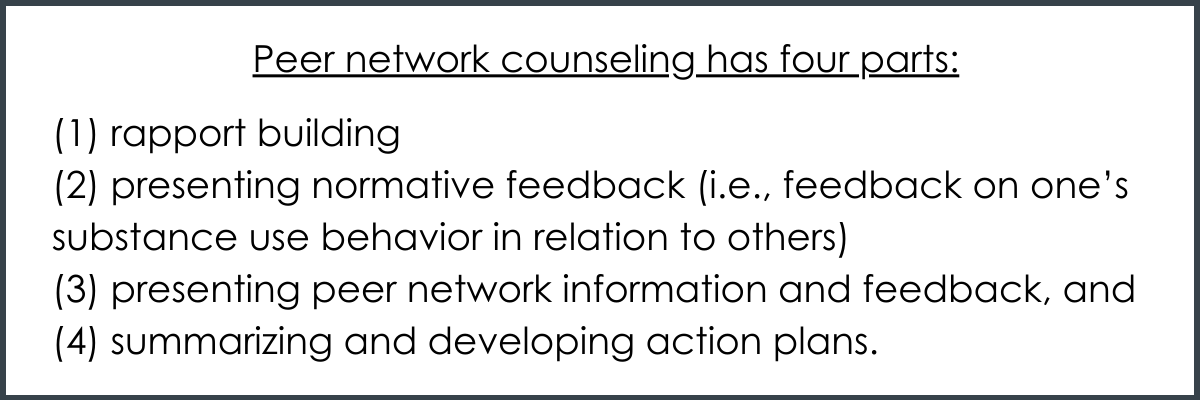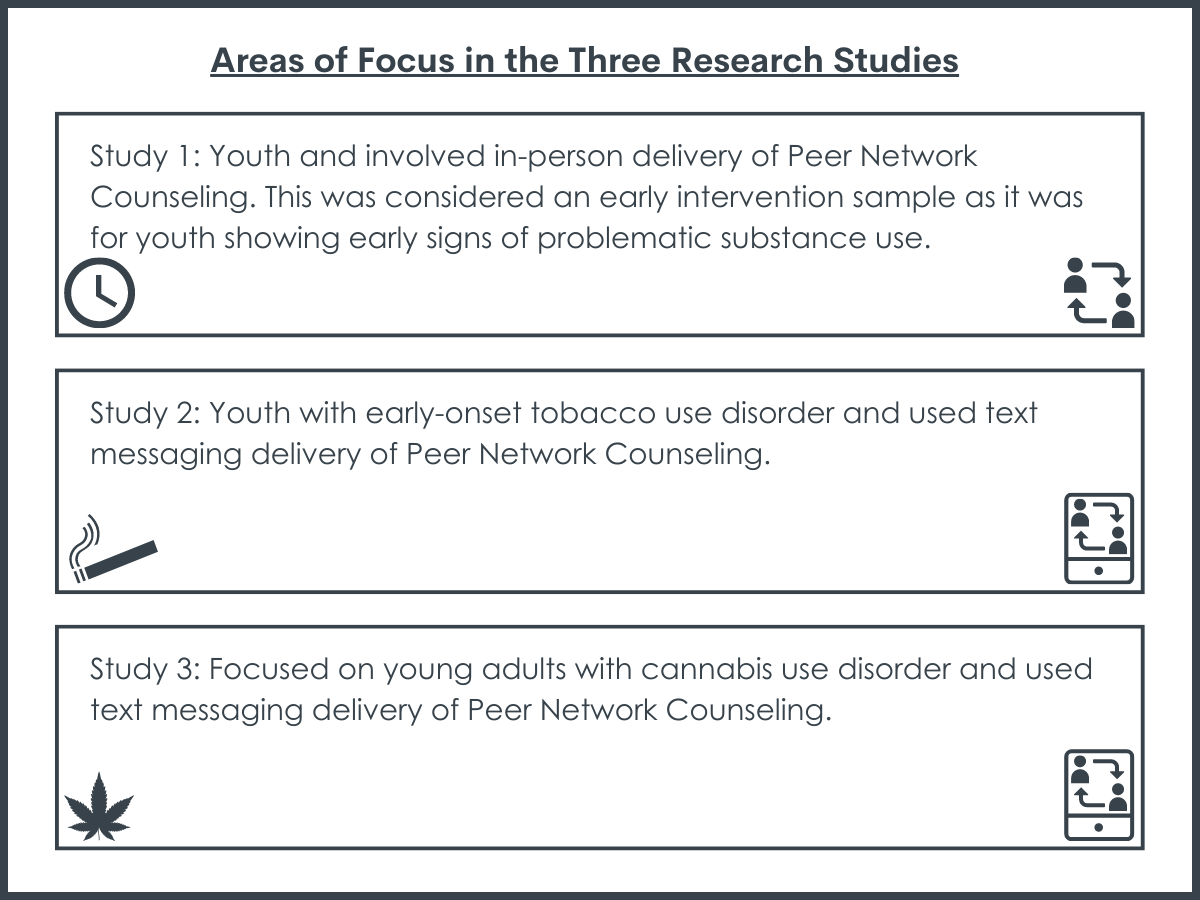Intervening with youth who have started to experiment with alcohol or other drugs is often key to stopping escalation. Brief interventions may be a cost-efficient approach, but there is a gap in understanding who may respond best. This study examined a brief, socially-based intervention, Peer Network Counseling, to answer these questions.
WHAT PROBLEM DOES THIS STUDY ADDRESS?
The vast majority of individuals who use alcohol or other drugs begin as adolescents or young adults. Intervention at this stage is key to preventing substance use from escalating and early treatment may reduce the likelihood of a substance use disorder. For young people especially, social network influence is often a key component of their substance use behavior. Interventions that attend to social groups and close relationships are therefore more likely to have positive effects among young people.
There are a variety of intervention approaches that have been tested, and among these, brief interventions are often recommended as they are more feasible to implement and have demonstrated positive results. Brief interventions can take a variety of forms but given the emphasis on social influence in substance use, interventions which capitalize on positive social network change and protect against negative influences may be most effective in slowing or stopping substance use.
This study examined whether the brief intervention, Peer Network Counseling, was helpful across a diverse group of youth and young adults. It also explored whether any important factors made the intervention more or less useful in reducing substance use.
HOW WAS THIS STUDY CONDUCTED?
This study used individual participant data meta-analysis to combine three primary studies where youth or young adult participants (ages 14-25) were randomized to a treatment or control group. The studies were conducted by the same research group. The treatment group in these studies received a brief peer network counseling intervention. The intervention was “brief” by design and could be delivered in person during a primary care visit or via text message. The control condition was described as either an attention control or a waitlist control group.

Peer network counseling has four parts: (1) rapport building, (2) presenting normative feedback (i.e., feedback on one’s substance use behavior in relation to others), (3) presenting peer network information and feedback (see Figure 2), and (4) summarizing and developing action plans. The in-person delivery takes place in one setting and lasts about 20 minutes. The text message delivery option involves text message automated “conversations.” In Study 2, these conversations occurred every other day for a total of 5 days. Each day focused on a different component of the intervention. In Study 3, the conversations occurred every other day over a 30-day period. Each week focused on a different component of the intervention.

Figure 2. This theoretical impact of peer networks on adolescent substance use behaviors plays a key role in part 3 of the Peer Network Counseling intervention: Presenting peer network information and feedback.
Study 1 focused on youth and involved in-person delivery of Peer Network Counseling: this was considered an early intervention sample as it was for youth showing early signs of problematic substance use. Study 2 focused on youth with early-onset tobacco use disorder and used text messaging delivery of the peer network counseling. Study 3 focused on young adults with cannabis use disorder and used text messaging delivery of the peer network intervention.

In this analysis, the data collected at baseline, 1-month post-intervention, and 3-months post-intervention was used. The outcomes included the frequency of cannabis, alcohol, tobacco, and other drugs in the past 30 days. The following variables were also included in the models: sex (male/female), race (white, black, other), and age. The models used in the individual participant data meta-analysis allowed the researchers to examine changes in substance use by their intervention condition at different time points. The analytic approach allowed the study to predict changes in substance use over time that account for previous substance use levels.
Of the analytic sample of 421 youth and young adults, 55% were female, 69% were Black/African American, and they were about 17 years old, on average.
WHAT DID THIS STUDY FIND?
Across the entire sample, Peer Network Counseling did not reduce substance use compared to the control group.
From baseline to 1-month after the intervention, participants in the Peer Network Counseling intervention had slightly reduced their cannabis, alcohol, tobacco, and other drug use, but not any more so than youth who were assigned to a control condition. The findings were similar at the 3-month follow-up, with even smaller differences at this time point. The findings do not point to an initial or delayed response to the intervention compared to a control condition. Also of note, the two types of intervention delivery (in-person versus text message) produced similar results.
Peer Network Counseling produced stronger effects among youth with more severe baseline levels of substance use.

When the authors examined the degree of impact of the Peer Network Counseling intervention compared to the control condition by participants’ baseline level of use of that substance, they found that a participant’s frequency of use at baseline was important to consider. These findings also varied by the substance of use and the length of follow-up. That is, participants in the intervention had the greatest reduction in substance use when starting with more frequent substance use and only in the short-term. This relationship changed depending on which substance they were reporting on and when they were reporting it: it was only apparent for the use of “other” drugs and marijuana. Between the baseline assessment and 1-month, those with the heaviest use of “other” drugs (any drug except cannabis) had the largest reduction in other drug use, a finding not sustained from 1 to 3 months. Between the 1- and 3-month period, those with the heaviest use of marijuana had the largest reduction in marijuana use.

WHAT ARE THE IMPLICATIONS OF THE STUDY FINDINGS?
This secondary data analysis that combined three clinical randomized controlled trials with youth and young adults did not find any additional benefit, on average, of a brief in-person or text intervention for substance use among youth over a 3-month folllow-up when compared to the control condition, but highlighted the potential value of conducting analyses of sub-groups to understand more about which youth in particular may or may not benefit from receipt of this kind of intervention.
The Peer Network Counseling brief intervention – about 15 minutes for the in-person format – was not found to be helpful on average for the studied youth, but similar to other brief interventions, it did result in reduced frequency of substance use among those participants with the most frequent levels of drug use other than cannabis (from baseline to 1-month post-intervention) and for cannabis use from 1-3 months after the intervention. Notably, given the briefness of the intervention, and low clinical burden of the automated text message based format tested in two of the three studies, it may still be a viable and low-bar-of-entry approach for intervening with youth who demonstrate higher levels of substance use but do not yet meet the criteria for formal treatment engagement. In the growing area of brief interventions for youth and young adults, these findings answer some important questions about what approach might work best, and for whom. As well, the combination of multiple studies to examine these pathways, and the use of an analytic approach to account for regression to the mean (i.e., over time, high levels of use often return to lower levels) are important methodological contributions.




